| 登録情報 | データベース: PDB / ID: 4d2g
|
|---|
| タイトル | Crystal structure of human PCNA in complex with p15 peptide |
|---|
 要素 要素 | - P15
- PROLIFERATING CELL NUCLEAR ANTIGEN
|
|---|
 キーワード キーワード | TRANSCRIPTION |
|---|
| 機能・相同性 |  機能・相同性情報 機能・相同性情報
positive regulation of deoxyribonuclease activity / dinucleotide insertion or deletion binding / PCNA-p21 complex / mitotic telomere maintenance via semi-conservative replication / purine-specific mismatch base pair DNA N-glycosylase activity / nuclear lamina / positive regulation of DNA-directed DNA polymerase activity / Polymerase switching / MutLalpha complex binding / Telomere C-strand (Lagging Strand) Synthesis ...positive regulation of deoxyribonuclease activity / dinucleotide insertion or deletion binding / PCNA-p21 complex / mitotic telomere maintenance via semi-conservative replication / purine-specific mismatch base pair DNA N-glycosylase activity / nuclear lamina / positive regulation of DNA-directed DNA polymerase activity / Polymerase switching / MutLalpha complex binding / Telomere C-strand (Lagging Strand) Synthesis / Processive synthesis on the lagging strand / PCNA complex / Removal of the Flap Intermediate / Processive synthesis on the C-strand of the telomere / Polymerase switching on the C-strand of the telomere / Mismatch repair (MMR) directed by MSH2:MSH3 (MutSbeta) / Mismatch repair (MMR) directed by MSH2:MSH6 (MutSalpha) / Transcription of E2F targets under negative control by DREAM complex / Removal of the Flap Intermediate from the C-strand / replisome / response to L-glutamate / centrosome cycle / response to dexamethasone / histone acetyltransferase binding / DNA polymerase processivity factor activity / G1/S-Specific Transcription / leading strand elongation / nuclear replication fork / replication fork processing / SUMOylation of DNA replication proteins / PCNA-Dependent Long Patch Base Excision Repair / response to cadmium ion / translesion synthesis / estrous cycle / mismatch repair / response to UV / cyclin-dependent protein kinase holoenzyme complex / base-excision repair, gap-filling / DNA polymerase binding / liver regeneration / epithelial cell differentiation / positive regulation of DNA repair / TP53 Regulates Transcription of Genes Involved in G2 Cell Cycle Arrest / Translesion synthesis by REV1 / Translesion synthesis by POLK / Translesion synthesis by POLI / positive regulation of DNA replication / Gap-filling DNA repair synthesis and ligation in GG-NER / replication fork / nuclear estrogen receptor binding / male germ cell nucleus / Termination of translesion DNA synthesis / Recognition of DNA damage by PCNA-containing replication complex / Translesion Synthesis by POLH / receptor tyrosine kinase binding / HDR through Homologous Recombination (HRR) / Dual Incision in GG-NER / cellular response to xenobiotic stimulus / cellular response to hydrogen peroxide / Dual incision in TC-NER / Gap-filling DNA repair synthesis and ligation in TC-NER / cellular response to UV / response to estradiol / E3 ubiquitin ligases ubiquitinate target proteins / heart development / chromatin organization / molecular adaptor activity / damaged DNA binding / chromosome, telomeric region / DNA replication / regulation of cell cycle / nuclear body / DNA damage response / centrosome / chromatin binding / chromatin / protein-containing complex binding / perinuclear region of cytoplasm / enzyme binding / negative regulation of transcription by RNA polymerase II / extracellular exosome / nucleoplasm / identical protein binding / nucleus類似検索 - 分子機能 PCNA-associated factor, histone-like domain / PCNA-associated factor / PCNA-associated factor histone like domain / Box / Proliferating Cell Nuclear Antigen / Proliferating Cell Nuclear Antigen - #10 / Proliferating cell nuclear antigen signature 2. / Proliferating cell nuclear antigen, PCNA, conserved site / Proliferating cell nuclear antigen signature 1. / Proliferating cell nuclear antigen, PCNA ...PCNA-associated factor, histone-like domain / PCNA-associated factor / PCNA-associated factor histone like domain / Box / Proliferating Cell Nuclear Antigen / Proliferating Cell Nuclear Antigen - #10 / Proliferating cell nuclear antigen signature 2. / Proliferating cell nuclear antigen, PCNA, conserved site / Proliferating cell nuclear antigen signature 1. / Proliferating cell nuclear antigen, PCNA / Proliferating cell nuclear antigen, PCNA, N-terminal / Proliferating cell nuclear antigen, PCNA, C-terminal / Proliferating cell nuclear antigen, N-terminal domain / Proliferating cell nuclear antigen, C-terminal domain / : / Alpha Beta類似検索 - ドメイン・相同性 Proliferating cell nuclear antigen / PCNA-associated factor類似検索 - 構成要素 |
|---|
| 生物種 |  HOMO SAPIENS (ヒト) HOMO SAPIENS (ヒト)
SYNTHETIC CONSTRUCT (人工物) |
|---|
| 手法 |  X線回折 / X線回折 /  シンクロトロン / シンクロトロン /  分子置換 / 解像度: 2.65 Å 分子置換 / 解像度: 2.65 Å |
|---|
 データ登録者 データ登録者 | DeBiasio, A. / Ibanez, A. / Mortuza, G. / Molina, R. / Cordeiro, T.N. / Castillo, F. / Villate, M. / Merino, N. / Lelli, M. / Diercks, T. ...DeBiasio, A. / Ibanez, A. / Mortuza, G. / Molina, R. / Cordeiro, T.N. / Castillo, F. / Villate, M. / Merino, N. / Lelli, M. / Diercks, T. / Luque, I. / Bernardo, P. / Montoya, G. / Blanco, F.J. |
|---|
 引用 引用 |  ジャーナル: Nat.Commun. / 年: 2015 ジャーナル: Nat.Commun. / 年: 2015
タイトル: Structure of P15(Paf)-PCNA Complex and Implications for Clamp Sliding During DNA Replication and Repair.
著者: De Biasio, A. / De Opakua, A.I. / Mortuza, G.B. / Molina, R. / Cordeiro, T.N. / Castillo, F. / Villate, M. / Merino, N. / Delgado, S. / Gil-Carton, D. / Luque, I. / Diercks, T. / Bernado, P. ...著者: De Biasio, A. / De Opakua, A.I. / Mortuza, G.B. / Molina, R. / Cordeiro, T.N. / Castillo, F. / Villate, M. / Merino, N. / Delgado, S. / Gil-Carton, D. / Luque, I. / Diercks, T. / Bernado, P. / Montoya, G. / Blanco, F.J. |
|---|
| 履歴 | | 登録 | 2014年5月9日 | 登録サイト: PDBE / 処理サイト: PDBE |
|---|
| 改定 1.0 | 2015年3月18日 | Provider: repository / タイプ: Initial release |
|---|
| 改定 1.1 | 2015年3月25日 | Group: Database references |
|---|
| 改定 1.2 | 2023年12月20日 | Group: Data collection / Database references ...Data collection / Database references / Other / Refinement description
カテゴリ: chem_comp_atom / chem_comp_bond ...chem_comp_atom / chem_comp_bond / database_2 / pdbx_database_status / pdbx_initial_refinement_model
Item: _database_2.pdbx_DOI / _database_2.pdbx_database_accession / _pdbx_database_status.status_code_sf |
|---|
| 改定 1.3 | 2024年11月6日 | Group: Structure summary
カテゴリ: pdbx_entry_details / pdbx_modification_feature |
|---|
|
|---|
 データを開く
データを開く 基本情報
基本情報 要素
要素 キーワード
キーワード 機能・相同性情報
機能・相同性情報 HOMO SAPIENS (ヒト)
HOMO SAPIENS (ヒト) X線回折 /
X線回折 /  シンクロトロン /
シンクロトロン /  分子置換 / 解像度: 2.65 Å
分子置換 / 解像度: 2.65 Å  データ登録者
データ登録者 引用
引用 ジャーナル: Nat.Commun. / 年: 2015
ジャーナル: Nat.Commun. / 年: 2015 構造の表示
構造の表示 Molmil
Molmil Jmol/JSmol
Jmol/JSmol ダウンロードとリンク
ダウンロードとリンク ダウンロード
ダウンロード 4d2g.cif.gz
4d2g.cif.gz PDBx/mmCIF形式
PDBx/mmCIF形式 pdb4d2g.ent.gz
pdb4d2g.ent.gz PDB形式
PDB形式 4d2g.json.gz
4d2g.json.gz PDBx/mmJSON形式
PDBx/mmJSON形式 その他のダウンロード
その他のダウンロード 4d2g_validation.pdf.gz
4d2g_validation.pdf.gz wwPDB検証レポート
wwPDB検証レポート 4d2g_full_validation.pdf.gz
4d2g_full_validation.pdf.gz 4d2g_validation.xml.gz
4d2g_validation.xml.gz 4d2g_validation.cif.gz
4d2g_validation.cif.gz https://data.pdbj.org/pub/pdb/validation_reports/d2/4d2g
https://data.pdbj.org/pub/pdb/validation_reports/d2/4d2g ftp://data.pdbj.org/pub/pdb/validation_reports/d2/4d2g
ftp://data.pdbj.org/pub/pdb/validation_reports/d2/4d2g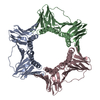
 リンク
リンク 集合体
集合体
 要素
要素 HOMO SAPIENS (ヒト) / プラスミド: CDFDUET1 / 発現宿主:
HOMO SAPIENS (ヒト) / プラスミド: CDFDUET1 / 発現宿主: 
 X線回折
X線回折 試料調製
試料調製 シンクロトロン / サイト:
シンクロトロン / サイト:  SLS
SLS  / ビームライン: X06SA / 波長: 1
/ ビームライン: X06SA / 波長: 1  解析
解析 分子置換
分子置換 ムービー
ムービー コントローラー
コントローラー



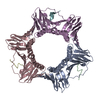
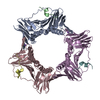

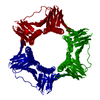


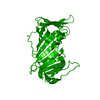
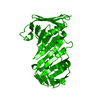
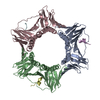
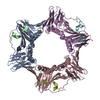
 PDBj
PDBj
















